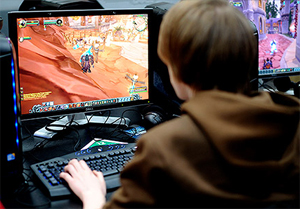 Bhopal, Madhya Pradesh, India
Bhopal, Madhya Pradesh, India dr.vaibhavdubey@gmail.com
dr.vaibhavdubey@gmail.com
Opening Hours : Monday to Saturay - 6 PM to 9 PM
Opening Hours : Monday to Saturay - 6 PM to 9 PM

Persistent and recurrent use of the Internet to engage in games, often with other players,
leading to clinically significant impairment or distress as indicated by five (or more) of the
following in a 12-month period:
1. Preoccupation with Internet games. (The individual thinks about previous gaming
activity or anticipates playing the next game; Internet gaming becomes the dominant
activity in daily life).
Note: This disorder is distinct from Internet gambling, which is included under gambling
disorder.
2. Withdrawal symptoms when Internet gaming is taken away. (These symptoms are typically
described as irritability, anxiety, or sadness, but there are no physical signs of
pharmacological withdrawal.)
3. Tolerance—the need to spend increasing amounts of time engaged in Internet games.
4. Unsuccessful attempts to control the participation in Internet games.
5. Loss of interests in previous hobbies and entertainment as a result of, and with the exception
of, Internet games.
6. Continued excessive use of Internet games despite knowledge of psychosocial problems.
7. Has deceived family members, therapists, or others regarding the amount of Internet
gaming.
8. Use of Internet games to escape or relieve a negative mood (e.g., feelings of helplessness,
guilt, anxiety).
9. Has jeopardized or lost a significant relationship, job, or educational or career opportunity
because of participation in Internet games
Diagnostic Features
Gambling disorder is currently the only non-substance-related disorder proposed for inclusion
with DSM-5 substance-related and addictive disorders. However, there are other
behavioral disorders that show some similarities to substance use disorders and gambling
disorder for which the word addiction is commonly used in nonmedical settings, and the
one condition with a considerable literature is the compulsive playing of Internet games.
Internet gaming has been reportedly defined as an “addiction” by the Chinese government,
and a treatment system has been set up. Reports of treatment of this condition have
appeared in medical journals, mostly from Asian countries and some in the United States.
The DSM-5 work group reviewed more than 240 articles and found some behavioral
similarities of Internet gaming to gambling disorder and to substance use disorders. The
literature suffers, however, from lack of a standard definition from which to derive prevalence
data. An understanding of the natural histories of cases, with or without treatment,
is also missing. The literature does describe many underlying similarities to substance addictions,
including aspects of tolerance, withdrawal, repeated unsuccessful attempts to cut
back or quit, and impairment in normal functioning. Further, the seemingly high prevalence
rates, both in Asian countries and, to a lesser extent, in the West, justified inclusion of
this disorder in Section III of DSM-5.
Internet gaming disorder has significant public health importance, and additional research
may eventually lead to evidence that Internet gaming disorder (also commonly referred
to as Internet use disorder, Internet addiction, or gaming addiction) has merit as an
independent disorder. As with gambling disorder, there should be epidemiological studies
to determine prevalence, clinical course, possible genetic influence, and potential biological
factors based on, for example, brain imaging data.
Internet gaming disorder is a pattern of excessive and prolonged Internet gaming that results
in a cluster of cognitive and behavioral symptoms, including progressive loss of control
over gaming, tolerance, and withdrawal symptoms, analogous to the symptoms of substance
use disorders. As with substance-related disorders, individuals with Internet gaming
disorder continue to sit at a computer and engage in gaming activities despite neglect of
other activities. They typically devote 8–10 hours or more per day to this activity and at least
30 hours per week. If they are prevented from using a computer and returning to the game,
they become agitated and angry. They often go for long periods without food or sleep. Normal obligations, such as school or work, or family obligations are neglected. This condition is
separate from gambling disorder involving the Internet because money is not at risk.
The essential feature of Internet gaming disorder is persistent and recurrent participation
in computer gaming, typically group games, for many hours. These games involve
competition between groups of players (often in different global regions, so that duration
of play is encouraged by the time-zone independence) participating in complex structured
activities that include a significant aspect of social interactions during play. Team aspects
appear to be a key motivation. Attempts to direct the individual toward schoolwork or interpersonal
activities are strongly resisted. Thus personal, family, or vocational pursuits
are neglected. When individuals are asked, the major reasons given for using the computer
are more likely to be “avoiding boredom” rather than communicating or searching
for information.
The description of criteria related to this condition is adapted from a study in China. Until
the optimal criteria and threshold for diagnosis are determined empirically, conservative
definitions ought to be used, such that diagnoses are considered for endorsement of
five or more of nine criteria.